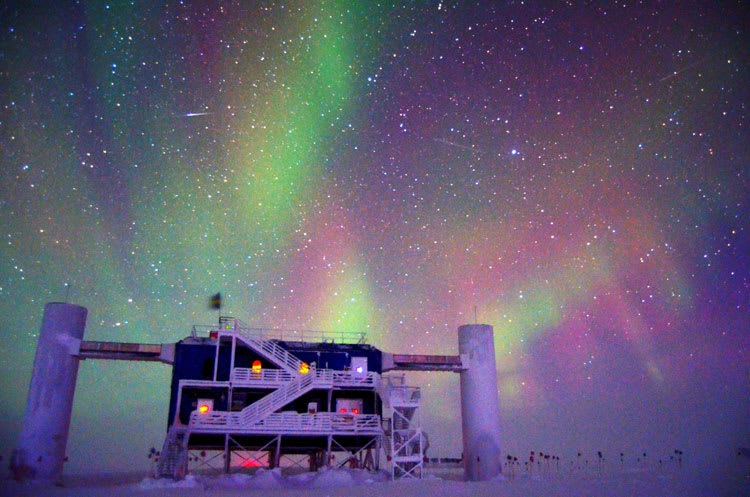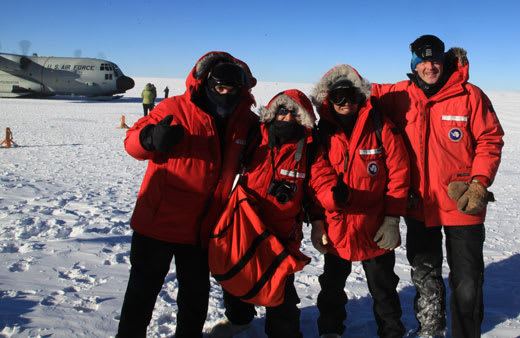
Official position listings are available at https://wipac.wisc.edu/careers
It takes a lot people power to run the IceCube Neutrino Observatory. An international collaboration that includes hundreds of physicists, engineers, computer scientists, and administrators works year-round to run the detector, analyze data, and develop new projects.
On-site, during the dark South Pole winter, it only takes two people: the winterovers.
In March, the sun sets in Antarctica and it doesn’t rise again until October. During the months of darkness, a skeleton crew of approximately 50 people called “winterovers” lives in the Amundsen-Scott South Pole Station.
Two of them are dedicated to the maintenance and operation of IceCube, although all winterovers are expected to serve the community in multiple ways; they are all trained as firefighters and are responsible for general station tasks like cleaning, season closing, and kitchen work.
Skill Sets
The job is demanding, and so are the requirements. The best candidates have technical experience, great communication skills, and an eagerness to take initiative on projects.
“Winterovers generally have backgrounds in engineering, computer science, or physics,” says Ralf Auer, a former IceCube winterover and the current winterover manager. “Since we have two people working at the station over winter, we try to make a match with someone who has a different skill set.”
Applicants are encouraged to have a master’s degree in physics, electrical engineering, computer science, or a related field. In addition, experience in administering UNIX operating systems and using programming languages like bash, python, and perl is required.
Besides technical requirements, Auer explains that they are looking for “open-minded personalities, team workers, and people who can adapt.”
Challenges and Rewards
Winter life at the South Pole station is not easy. Both Auer and Freija Descamps, who wintered over during the 2010-2011 season, cited isolation as the biggest challenge to wintering over. With all the difficulties, station residents do find ways to relax and enjoy themselves.
“The hardest part was dealing with the medical emergencies that occurred at the station. On top of the stress and worrying because they were my friends, it also showed how isolated we were,” explained Descamps. At the same time, she says, “In our winter, we had a really active social agenda, with cooking on Sundays, movie-making, lectures, yoga, and more.”
Daily Life
With no daily sunrise, it’s important for winterovers to keep their own schedules. All winter residents at the South Pole station serve on either the fire response team or the trauma team and are expected to participate in station cleaning, “dish pit,” and other communal chores.
IceCube winterovers have scheduled work, like working on software or hardware, detector maintenance tasks, and addressing emergencies as they arise. Overall, they are responsible for keeping the detector running.
“Sometimes, IceCube’s automated system would wake me up if something was wrong. This could be anything from a few DOMs (digital optical modules) that stopped data-taking to the data acquisition server crashing,” said Descamps.
Much of the detector work can be done from the station, but winterovers often visit the IceCube Lab. Known as the ICL, it is located approximately one kilometer from the station. Descamps admitted to taking every opportunity to visit the ICL, to see the auroras, sunset or sunrise, or night sky.
After the Winter
Auer and Descamps were both trained as physicists before working for IceCube, and both have stayed within the physics community. In addition to managing winterovers, Auer is a System Administrator for the South Pole System, responsible for data coming off the detector.
Descamps is currently a postdoctoral researcher at Lawrence Berkeley National Laboratory in Berkeley, California. She works on a low-energy neutrino detector called SNO+, located in a mine in Canada.
Wintering over is unforgettable, from the feeling of accomplishment to the breathtaking beauty of the night sky.
“It’s really a great opportunity,” says Auer. “I wouldn’t want to have missed that time. It was great. It’s hard to put into words.”
The official position listing is available at http://wipac.wisc.edu/jobs/show/winterover
